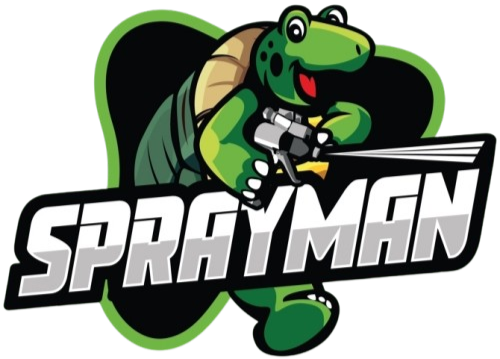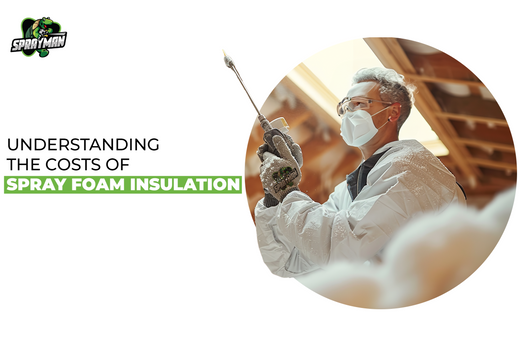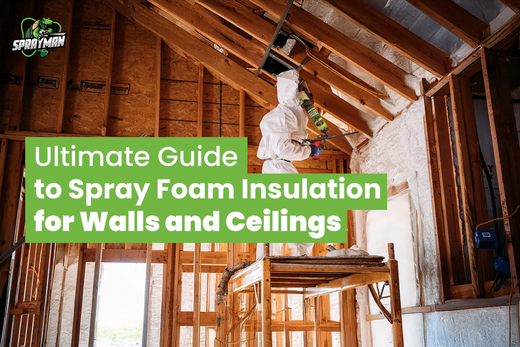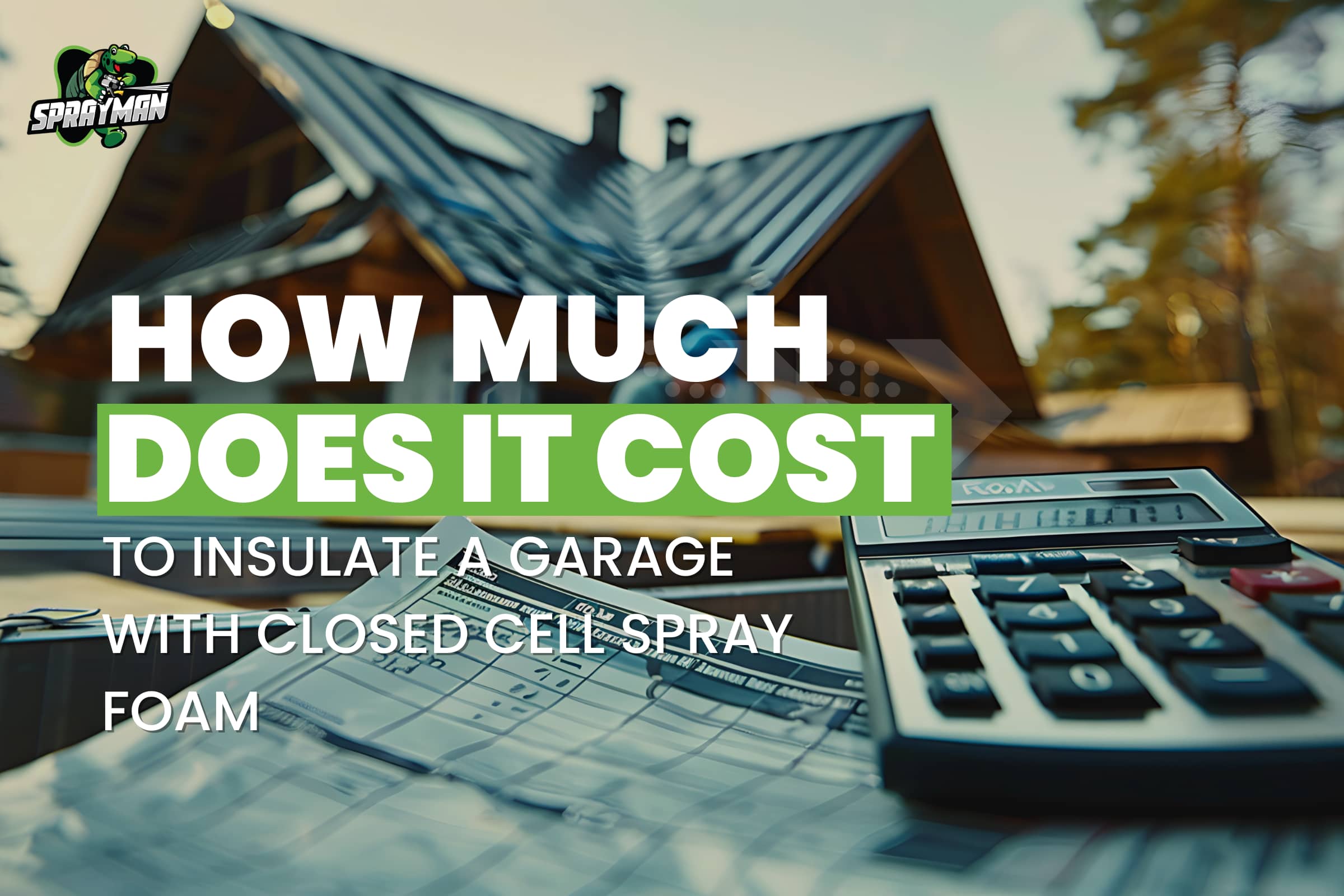Spray foam insulation remains one of the most effective ways to boost energy efficiency, improve indoor comfort, and reduce long-term heating and cooling costs. But when it comes to budgeting an insulation project, the first question most homeowners ask is simple: How much does spray foam insulation cost per square foot today?
In 2025, national averages place spray foam insulation cost per sq ft between $1.00 and $4.50, depending primarily on whether you choose open-cell or closed-cell foam. Larger projects, such as whole-home insulation, typically range around $6,000, though your final price will vary based on foam type, required R-value, installation complexity, and whether you choose a DIY kit or hire a professional installer.
The pricing estimates in this updated guide draw from reputable industry sources including HomeAdvisor, HomeGuide, and real-world SPRAYMAN calculator data. Because spray foam costs can fluctuate based on regional labor rates, accessibility, and material thickness, understanding these factors upfront can help you budget more accurately and avoid surprises.
This comprehensive 2025 guide walks you through everything that affects spray foam insulation cost:
- open-cell vs closed-cell cost differences
- how square footage and R-value requirements influence pricing
- DIY spray foam insulation costs vs professional installation
- cost-saving strategies for homeowners
- real examples of spray foam costs across attics, crawl spaces, walls, and floors
By the end, you’ll know exactly what to expect and how to choose the most cost-effective insulation plan for your project without sacrificing quality or performance.

What Factors Determine the Cost of Spray Foam Insulation?
Spray foam insulation costs vary based on factors like labor, materials, and project complexity. Below are detailed insights into these factors.
Factors Affecting Both DIY and Professional Costs
1. Type and Thickness of Spray Foam
The type and thickness of spray foam insulation used significantly affect the installation cost. Open-cell and closed-cell are the two common types of spray foam insulation. Open-cell spray foam is generally less expensive than closed-cell spray foam due to its lower density and R-value. However, closed-cell spray foam provides superior thermal insulation and moisture resistance, making it more costly.
Spray foam insulation thickness is directly proportional to its R-value, meaning thicker insulation offers a higher R-value and therefore a higher cost. For example, open-cell spray foam offers an R-value of around 3.5 per inch, while closed-cell spray foam insulation R-value ranges from R5.6 to R7 per inch. Increasing thickness directly impacts both material needs and overall spray foam insulation cost.
2. Project Size and Insulation Location
The size of the insulation project, typically measured in square footage, significantly contributes to spray foam cost calculation. For example, using open-cell spray foam, the attic spray foam insulation cost is between $3,500 - $5,000, while closed-cell spray foam costs range from $4,500 to $7,000 for the same project size. Larger coverage areas require more insulation material, which increases costs for both DIY and professional installations.
In addition to project size, insulation location plays a crucial role in determining spray foam insulation cost. Where insulation is applied within a home significantly impacts costs, as different areas require varying levels of insulation based on their exposure to external conditions. For instance, attics generally need thicker insulation with higher R-values compared to walls, due to greater heat loss and exposure to outdoor temperatures.
Professional Installation-Specific Cost Factors
While some factors affect both DIY and professional installations, hiring professionals often involves unique considerations, primarily due to labor costs. For an average 1,000 sq.ft. project, spray foam companies typically charge labor costs between $1,500 and $5,000, depending on factors such as project scope, accessibility, complexity, and additional services.
1. Accessibility of the Installation Area
The accessibility of the installation area significantly impacts the cost of attic insulation and other hard-to-reach spaces. Professional contractors often charge higher rates for less accessible areas like crawl spaces or attics due to the additional time, effort, and materials required. For example, the cost to insulate a crawl space can exceed that of wall insulation, while attic insulation usually involves thicker layers and specialized equipment, increasing overall costs.
2. New vs. Existing Homes
Insulating existing homes can be more costly than new constructions. For example, spray foam insulation in existing walls may require removing old insulation and modifying wall structures, which adds to the total insulation cost. By contrast, installing spray foam in new homes is generally more straightforward, avoiding these additional steps and related expenses.
3. Additional Services and Preparation Needs
Professional insulation services may include additional steps such as vapor barrier installation, preparation, cleaning, and hazard removal. Vapor barriers are particularly crucial for open-cell spray foam, and typically costs $2 to $4 per square foot, depending on material thickness and labor rates.
DIY Spray Foam Insulation: Real-World Costs (Closed Cell)
Having explored the general factors affecting insulation costs, let’s dive into specific DIY cost examples for better clarity.
For homeowners looking to save on labor costs, DIY spray foam insulation offers a cost-effective way to insulate your home without breaking the bank. Closed-cell spray foam insulation kits for DIY projects typically range from $0.75 to $2.0 per square foot, depending on the brand, coverage, and quantity purchased. Accurately calculating costs requires considering the recommended R-value, the area size, and the thickness of spray foam insulation needed.

Detailed Analysis of DIY Closed Cell Spray Foam Costs
The table below provides a breakdown of closed-cell spray foam insulation costs for different areas in a home. These calculations are specific to Zone 3 and reflect varying insulation requirements across different areas of the home.
DIY Costs for Closed-Cell Spray Foam (Zone 3):
| Area | Uninsul. Attic | Crawl Space | Basement Wall | Uninsul. Floor |
| Rec. R-Value | R49–R60 | R13-R25 | R11 | R19 |
| Needed Thickness (inches) | 8.7 - 10.6 | 2.3-4.5 | 2 | 3.4 |
| Cost (50 sq.ft.) | $450 - $510 | $170 - $240 | $150 | $250 |
| Cost (100 sq.ft.) | $780 - $950 | $240 - $450 | $220 | $350 |
| Cost (200 sq.ft.) | $1,400 - $1,700 | $450 - $780 | $390 | $600 |
| Cost (500 sq.ft.) | $3,450 - $4,200 | $980 - $1,800 | $820 | $1,350 |
| Cost (1,000 sq.ft.) | $6,900 - $8,400 | $1,800 - $3,600 | $1,500 | $2,700 |
Essential Tools for Accurate DIY Spray Foam Cost Estimation
The estimates above provide a general guideline, but precise costs depend on various factors. To calculate your exact DIY spray foam insulation cost:
- Determine Your R-Value Needs: Calculate the difference between your current R-value and the recommended R-value for your area.
- Use the Sprayman Calculator: Enter your area size and R-value requirements into the Spray Foam Insulation Cost Calculator to find the exact number of cans needed.
- Plan Your Purchase: Combine sets and individual cans strategically to minimize costs.
What Is the Cost of Hiring Professionals for Spray Foam Insulation?
On average, the cost of hiring professionals for spray foam insulation typically ranges between $1.00 and $4.50 per square foot, including material costs. Labor expenses generally account for 30% to 50% of the total project cost, or $50 to $100 per hour, according to industry experts such as HomeAdvisor, HomeGuide, and other trusted insulation resources. Professional contractors deliver effective insulation services, though often at a higher overall cost.
The table below outlines estimated labor costs for professional insulation with spray foam (1,000 sq.ft.). The average total costs may vary depending on factors such as the type of material used (open-cell or closed-cell), the achieved R-value, and other project-specific considerations.
| Area | Average Total Cost (1000 sq.ft.) | Labor Cost (%30-%50) |
| Uninsul. Attic | $10,000 | $3,000 - $5,000 |
| Crawl Space | $6,000 | $1,800 - $3,000 |
| Basement Wall | $6,000 | $1,800 - $3,000 |
| Uninsul. Floor | $7,000 | $2,100 - $3,500 |
DIY vs. Professional Spray Foam Installation: What's Best For Your Budget?
DIY spray foam insulation is a budget-friendly option for home insulation. Homeowners often fear the high labor costs associated with professional spray foam installation, which can nearly double the total insulation cost. In comparison, DIY spray foam installation eliminates labor costs while equipping you with valuable skills.
For smaller projects, DIY may be the better choice; however, for larger and more complex jobs, the expertise of professionals often ensures optimal results.
Ultimately, your choice will depend on your budget, project size, and level of expertise.
How Can You Lower the Costs of Spray Foam Insulation?
To lower spray foam insulation costs effectively, smart planning and resource utilization are essential. Here are strategies to save costs without compromising quality:
- Insulate During Construction: Install insulation during the initial construction phase to avoid the need for costly removals and replacements later.
- Consider DIY Spray Foam Insulation for Cost Savings: DIY insulation can save you significant costs compared to professional installation.
- Shop Around for Contractors: Don’t commit to the first installer you talk to. Instead, solicit and compare multiple quotes.
- Utilize Tax Credits for Energy Efficiency: Take advantage of financial incentives such as the Energy-Efficient Home Improvement Credit, which offers a 30% tax credit on installation costs of qualifying improvements, with a maximum claim of $1,200 annually.
Spray Foam Insulation Benefits: Is It Worth the Cost?
Spray foam insulation is worth every single penny spent on installing it. It offers superior thermal insulation than other types of insulation by creating an air seal.
Here are some long-term benefits of spray foam insulation:
- Energy Savings: Up to 30% reduction in energy consumption.
- Comfort: Consistent indoor temperatures year-round.
- Moisture Resistance: Prevents water infiltration and mold growth.
- Soundproofing: Blocks external noise effectively.
- Durability: Lasts up to 80 years without losing efficiency.
- Increased Home Value: Enhances structural strength and resale value.
For more information you can read our article titled "Top 6 Key Benefits of Spray Foam Insulation for Enhanced Efficiency and Value".

Conclusion
Choosing the right insulation method—DIY or professional—depends on your specific project needs. Regardless of the choice, spray foam insulation ensures long-term savings and enhanced home comfort.
Take action today for a better tomorrow!
FAQs
Why Do Cost Estimates for Spray Foam Insulation Vary Across Sources?
Spray foam insulation cost estimates can differ because not all sources specify the insulation thickness or R-value requirements used in their calculations. Many estimates might represent open-cell foam or lower R-value targets, resulting in lower costs but potentially reduced insulation performance. Our calculations are based on recommended R-values for optimal energy efficiency, ensuring accurate and comprehensive cost estimates
How Much Does It Cost to Insulate a Garage with Spray Foam?
The cost to insulate a garage with closed cell spray foam costs between $1,500 and $15,000 depending on whether you’re insulating a 1-car or 3-car garage. For more details, refer to our Garage Spray Foam Insulation Cost Guide to calculate costs for your specific needs.
What Are the Different Types of Spray Foam Insulation?
There are two distinct types of spray foam insulation; closed-cell and open-cell spray foam insulation. Learn more about the specific types of spray foam insulation, including open-cell and closed-cell options, in our detailed comparison guide on "Find Your Ideal Type of Spray Foam Insulation: Open vs. Closed Cell Explained."
How to DIY Spray Foam Insulation in Walls and Ceilings?
DIY spray foam insulation involves preparing the area, applying the foam evenly, and allowing it to cure properly. This process can save money while improving energy efficiency. For a detailed step-by-step guide, check out our Walls & Ceilings Spray Foam Insulation Guide.
Why Are Attics and Roofs Ideal for Spray Foam Insulation?
Spray foam attic insulation is a profound solution for the unbearable heat and high energy bills you experience in your home. Learn more about how spray foam insulation can transform your attic by checking out our detailed guide on "Why Are Attics and Roofs Ideal for Spray Foam Insulation?"




Leave a comment
This site is protected by hCaptcha and the hCaptcha Privacy Policy and Terms of Service apply.